The AMD Radeon R9 Fury Review, Feat. Sapphire & ASUS
by Ryan Smith on July 10, 2015 9:00 AM ESTGrand Theft Auto V
The final game in our review of the R9 Fury X is our most recent addition, Grand Theft Auto V. The latest edition of Rockstar’s venerable series of open world action games, Grand Theft Auto V was originally released to the last-gen consoles back in 2013. However thanks to a rather significant facelift for the current-gen consoles and PCs, along with the ability to greatly turn up rendering distances and add other features like MSAA and more realistic shadows, the end result is a game that is still among the most stressful of our benchmarks when all of its features are turned up. Furthermore, in a move rather uncharacteristic of most open world action games, Grand Theft Auto also includes a very comprehensive benchmark mode, giving us a great chance to look into the performance of an open world action game.
On a quick note about settings, as Grand Theft Auto V doesn't have pre-defined settings tiers, I want to quickly note what settings we're using. For "Very High" quality we have all of the primary graphics settings turned up to their highest setting, with the exception of grass, which is at its own very high setting. Meanwhile 4x MSAA is enabled for direct views and reflections. This setting also involves turning on some of the advanced redering features - the game's long shadows, high resolution shadows, and high definition flight streaming - but not increasing the view distance any further.
Otherwise for "High" quality we take the same basic settings but turn off all MSAA, which significantly reduces the GPU rendering and VRAM requirements.
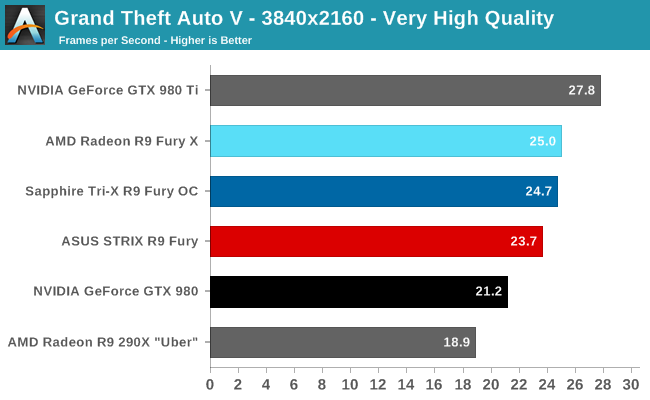
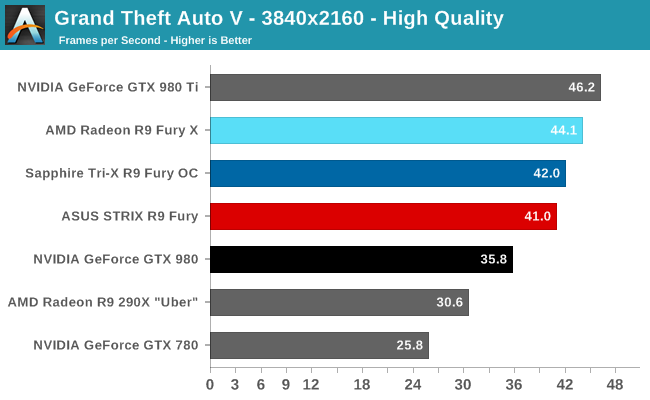
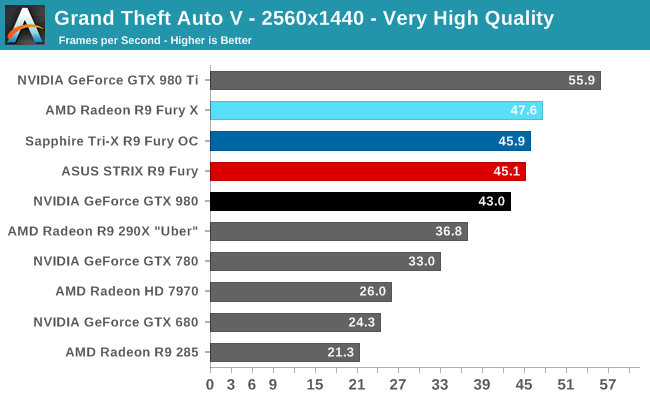
Closing out our gaming benchmarks, the R9 Fury is once again in the lead, besting the GTX 980 by as much as 15%. However GTA V also serves as a reminder that the R9 Fury doesn’t have quite enough power to game at 4K without compromises. And if we do shift back to 1440p, a more comfortable resolution for this card, AMD’s lead is down to just 5%. At that point the R9 Fury isn’t quite covering its price advantage.
Meanwhile compared to the R9 Fury X, we close out roughly where we started. The R9 Fury trails the more powerful R9 Fury X by 5-7% depending on the resolution, a difference that has more to do with GPU clockspeeds than the cut-down CU count. Overall the gap between the two cards has been remarkably consistent and surprisingly narrow.

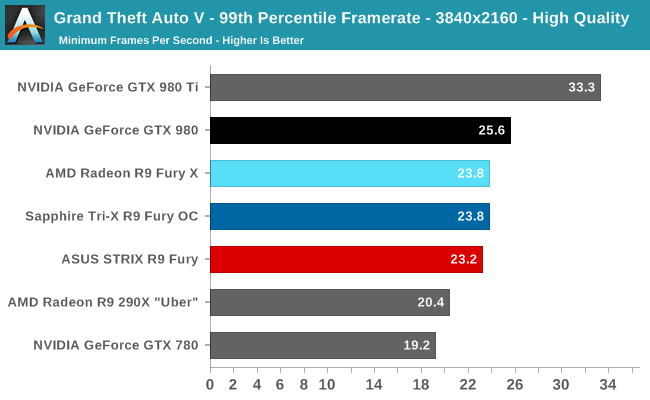
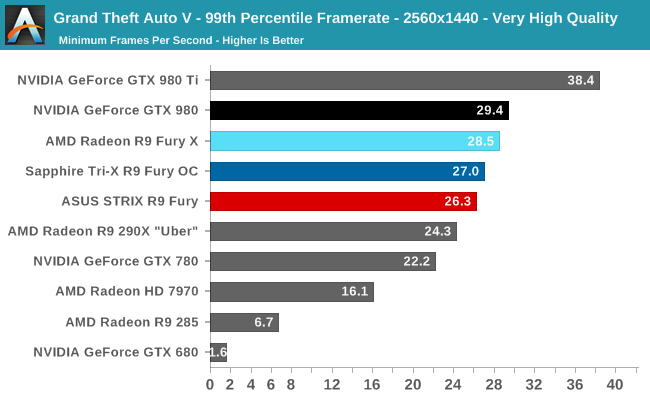
99th percentile framerates however are simply not in AMD’s favor here. Despite AMD’s driver optimizations and the fact that the GTX 980 only has 4GB of VRAM, the R9 Fury X could not pull ahead of the GTX 980, so the R9 Fury understandably fares worse. Even at 1440p the R9 Fury cards can’t quite muster 30fps, though in all fairness even the GTX 980 falls just short of this mark as well.










288 Comments
View All Comments
Sefem - Wednesday, July 15, 2015 - link
"Draw calls are the best metric we have right now to compare AMD Radeon to nVidia ON A LEVEL PLAYING FIELD."Well, lets just for a moment consider this as true (and you should try to explain why :D )
Looking at draw calls a GTX 980 should perform 2.5x faster than a 290X in DX11 (respectively 2.62M vs 1.05M draw calls) and even a GTX 960 would be 2.37x faster than the over mentioned 290X (respectively 2.49M vs 1.05M draw calls) :)
D. Lister - Friday, July 17, 2015 - link
Performing minor optimizations, on an API that isn't even out yet, to give themselves the appearance of a theoretical advantage in some arbitrary GPU function, as a desperate attempt to keep themselves relevant, is so very AMD (their motto should be, "we will take your money now, and give you its worth... later..., maybe.)Meanwhile people at NV are optimizing for the API that is currently actually being used to make games, and raising their stock value and market share while they're at it.
Why wouldn't AMD optimize for DX11, and instead do what it's doing? Because DX11 is a mature API, so any further improvements would be small, yet expensive, while DX12 isn't even out yet, so it would be comparatively cheaper to get bigger gains, and AMD is seriously low on funds.
Realistically, proper DX12 games are stll 2-3 years away. By that time AMD probably wouldn't even be around anymore.
Hence, in conclusion, whatever DX12 performance the Fury trio (or AMD in general) claims, means absolutely nothing at this point.
FlushedBubblyJock - Wednesday, July 15, 2015 - link
Thank GOD for nvidia or amd would have this priced so sky high no one could afford it.Instead of crazy high scalping greedy pricing amd only greeded up on price perf the tiny bit it could since it can't beat nvidia, who saved our wallets again !
THANK YOU NVIDIA ! YOUR COMPETITION HAS KEPT THE GREEDY RED TEAM FROM EXHORBITANT OVERPRICING LIKE THEY DID ON THEIR 290 SERIES !
f0d - Friday, July 10, 2015 - link
i wasnt really impressed with the fury-x at its price point and performancethis normal fury seems a bit better at it price point than the fury-x does
as i write this the information on overclocking wasnt finished - i sure hope the fury overclocks much better than fury-x did because that was a massive letdown when it came to overclocking, when nvidia can get some crazy high overclocks with its maxwell it kinda makex the fury line seem not as good with its meager overclocks the fury-x had
hopefully fury (non x) overclocks like a beast like the nvidia cards do
noladixiebeer - Friday, July 10, 2015 - link
AMD haven't unlocked the voltage yet on Fury X. Hopefully, they will unlock the voltage cap soon, so the Fury X should be able to overclock better. Better than 980ti? We'll see, but Fury X still has lots of uptapped resources.Chaser - Saturday, July 11, 2015 - link
Don't hold you breath. There is very little overhead in Fiji. That's clearly been divulged. As the article states Maxwell is very efficient and has a good deal of room for partners to indulge themselves. Especially the Ti.chrnochime - Friday, July 10, 2015 - link
The WC for the X makes up ~half of the price increase from non-x. For someone who's going to do moderate OC and don't want to bother doing WC conversion the X is a good choice, even over a Ti.cmdrdredd - Friday, July 10, 2015 - link
no it's not...the 980ti bests it handily. It's not a good choice at all when 980ti can overclock as well and many coolers have 0rpm fan modes for when it's at idle or very low usage.akamateau - Tuesday, July 14, 2015 - link
You haven't seen the DX12 Benchmarks yet. Anand has been keeping them from you. Once you see how much Radeon crushes nVidia you would never buy green again.nVidia silicon is RUBBISH with DX12 and Mantle. Radeon 290x is 33% faster than GTX 980Ti.
FlushedBubblyJock - Wednesday, July 15, 2015 - link
sefem already told you..." "Draw calls are the best metric we have right now to compare AMD Radeon to nVidia ON A LEVEL PLAYING FIELD."
Well, lets just for a moment consider this as true (and you should try to explain why :D )
Looking at draw calls a GTX 980 should perform 2.5x faster than a 290X in DX11 (respectively 2.62M vs 1.05M draw calls) and even a GTX 960 would be 2.37x faster than the over mentioned 290X (respectively 2.49M vs 1.05M draw calls) :) "
Now go back to stroking your amd spider platform.